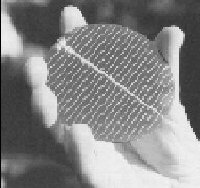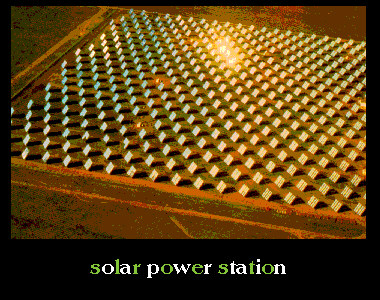
From sunshine to electric current
Solar cells turn radiation energy, which is produced in the sun, into electricity. Photons transport small packages of this solar energy. If the energetic photons hit the outer level electrons, the electrons are dislodged from the material. Silicon is a semiconductor and is often used as the base material for the production of solar cells. Silicon is neither a good conductor nor a good insulator - that's why it is called a semiconductor. The elementary two-dimensional picture of a pure silicon crystal helps us to see how this is done. Each silicon atom has a nucleus, it has 4 electrons in its outer shell with spaces for another 4. When the atom is surrounded by similar silicon atoms we find that its 4 electrons are shared with neighbouring atoms which in turn share electrons back. As a result of the sharing each nucleus appears to be surrounded by 8 electrons filling all possible places in that layer. This crystal structure is, therefore, very stable. As a consequence it is very hard to get electrical current to flow since, to do so, would mean disturbing these stable valence electrons. To get electrical currents to flow easily it is necessary to modify this pattern of stable valence electrons. This is done by "doping" the silicon crystal with special impurity elements-but which elements ? Boron has only 3 valence electrons, one less than silicon. Phosphorus has five, one more than silicon. When one atom in a silicon lattice is replaced by a phosphorus atom four of its electrons are used to give the same stable pattern as in a pure crystal lattice. There is one remaining electron not required to bind the crystal. It is of negative charge and is available to take part in current flow through the crystal. Phosphorus is called an n-type dopant since it gives rise to this mobile negative charge. When a silicon atom is replaced by a boron atom a different result occurs because there is one electron missing. Boron has only three electrons to share with its neighbours so that there is a 'hole' in the electronic structure of the silicon crystal. This hole, or absence of an electron, will mean that the positive charge on the adjacent silicon nucleus is not quite cancelled so this hole is a centre of positive charge. Boron is called a p-type dopant because it leads to a mobile positive charge. To produce a solar cell, you must put together a n-type and a p-type layer of these semiconductor materials. If photons hit the solar cell the energy of them is transfered to the valence level of electrons. The positively charged holes and the negatively-charged electrons attract each other. They form positive-negative pairs. This formation creates electricity. A photovoltaic cell is characterized by its open circuit voltage and short circuit current qualities. The open circuit voltage is the voltage on the output of the solar cell, when no current is flowing. It is the maximum voltage of one cell.

A solar cell [source: pic]
The short circuit current is the output current of the cell, when the positive output and the negative output of the solar cell are connected to each other. The electrical output is measured in terms of 'peak Watts'(Wp) or 'peak kilowatts' (KWp). It's the power a cell produce in bright sunlight (1000W/m^2 at 25 °C). A standard photovoltaic cell produces about 0.7 Wp. If you want to increase these electrical abilities, you have to connect the photovoltaic cells in series and parallel. If you connect the cells in series you can increase the output voltage and if you wire the cells in parallel you can increase the output current. So a solar module consists of solar cells wired together in parallel or in series. A solar array is a combination of solar modules. You get more electrical power and efficiency than from one cell. The common applications of solar arrays are water pumping, telecommunications equipment (e. g. the electrical power of a satellite), light for buoys, etc.

[source:pic]
(Technical English, FHTE, T.S. Wynne)
next page: solar panels